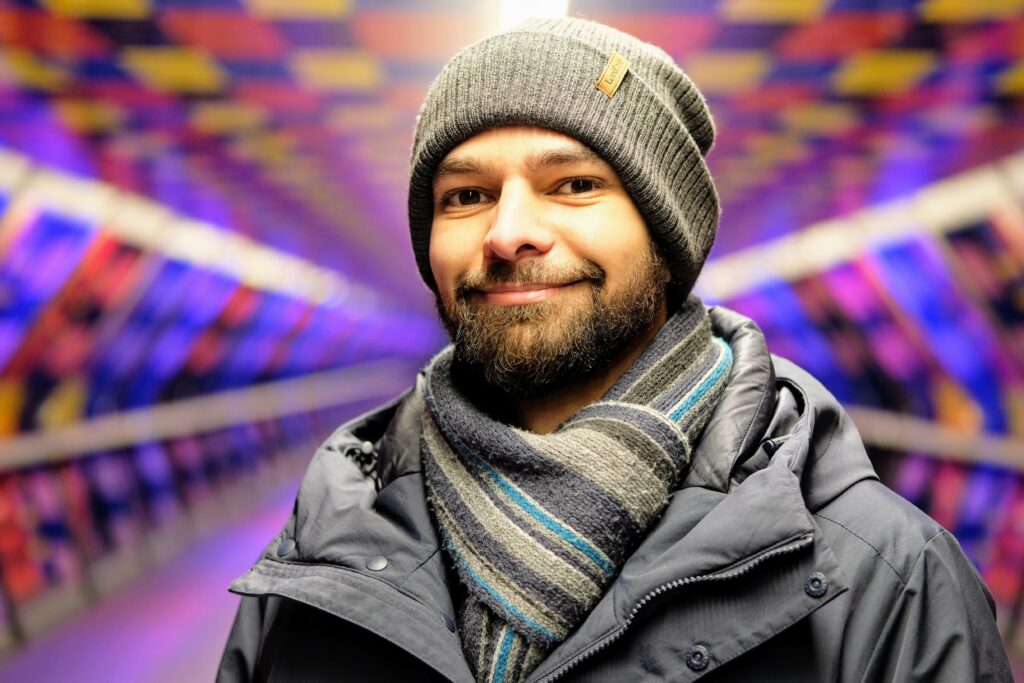Most people have dreamt about what the future looks like, but that future is already here for Hesham Dar – a Data Scientist and AI practitioner in Samsung Research. We talked with Hesham about how science fiction coloured his view on AI and how he wanted to be a part of developing the technology he saw on television shows such as Star Trek.
The fascination for AI in science fiction
AI and robots have been a part of science fiction since HG Well invented the genre in the 1800s. For example, Wells had robot-like devices as the centre point of his book The War of the Worlds, where Martians invade earth.
Hesham thinks people’s fascination for AI is to tell a story about ourselves as humans. He reasons that AI is a placeholder for a different aspect of humans and not about the AI itself.
– A few shows or movies have discussed at what point an AI has a consciousness, does it has its own life, its own self-awareness, things like that. I think that it is used as a device to reflect on ourselves and make us question ourselves. What is it about us that makes us self-conscious? What separates us from being machines? We can process information, we do stuff, but we think that there is something fundamentally different about us.

Hesham then reasons that some of the benefits often captured by these science fiction stories are how we humans often question and devaluate ourselves when an AI can do the same as us. For example, we take enormous pride in being creative and creating beautiful music, but what value do we have if an AI can do the same as us?
Hesham then points out that he would like to see more positive potential uses of AI or information systems and how these technologies might improve people’s lives.
Predicting the future is notoriously tricky. However, many people have tried regardless, and predicting the future of AI has been a science fiction obsession for many decades. Still, science fiction authors have often focused on humanoid AI where we have had the pleasure of meeting characters such as C-3PO from Star Wars or robots from the film iRobot.

Nevertheless, we don’t see many humanoid AIs in the real world. Instead, science fiction has often overlooked and failed to predict how accessible information has become and how data flows seamlessly between devices all over the planet. This data is then fed into different AI systems, often invisible for the user to, for example, suggest music or movies a person might like based on what the AI systems know about the individual.
In Hesham’s thought, it’s not easy to predict the future because we often try to draw parallels with current-day technology. He points out science fiction’s obsession with flying cars and that instead of having flying cars, we are on the verge of having self-driving cars. Authors tried to predict what cars would look like in the 2020s for many years, and they often drew parallels between the technologies they had at the time – cars and aeroplanes. While flying cars might be an item for the future, current science is trying to automate the often mundane task of driving with self-driving cars. Hesham points out that predicting the future is often about guessing how we might combine current-day technologies.
– What kind of magical device or technology can simplify the problem completely? [Authors] guess about it in lots of different ways. Sometimes they get it right, and sometimes they get off the mark.
Hesham adds that science fiction’s critical role is not accurately predicting the future but instead planting inspirational seeds in people by targeting problems in life and society and generating ideas to solve these problems with technology.
When the enabling technology matures and how it can solve the food crisis
We are currently going through an AI boom that started in the 2010s with neural networks at the centre of many recent advances. In many ways, this ‘AI summer’ was enabled by access to more computing power, both through improved chip design and easy access to large compute pools on the cloud for relatively little money up front.
Hesham explains that many of the algorithms going through a renaissance now are classical AI tasks in areas like computer vision and natural language processing that were invented in the past. Despite that, we are just now able to realise the algorithm’s full potential; thanks to considerable advances in accessible computing power.
Hesham believes that the next leap in AI will also come from algorithm improvements and designs. He mentions some relatively new techniques, such as attention networks and transformers.
The latter has enabled advanced text generation and interpretation and provided us with models such as GPT-3 that can generate text with quality so good that it can be challenging to determine whether humans or AI wrote the text.
Climate change is one of the big problems confronting the 21st century, and due to the overwhelming increase of the human population, food scarcity also poses a huge threat. Today, we dedicate a lot of land and resources to food production, and instead of devoting more resources, Hesham believes we can use technology to use scarce resources more effectively. He brings up an analogy to a food replicator in Star Trek, a fictional device that can materialise food out of thin air.
By many, 3D printing of food is seen as the next step in feeding the world population by converting ingredients that require less energy, such as plants and insects, into meals that resemble their energy-sensitive counterparts, such as Chicken, Steak or hamburger patty. Research conducted at London South Bank University looked at how flour made from crickets could be used to make food, mimicking the look and feel of more desirable meals. Food 3D printed from Cricket flour provides the same amount of protein as Chickens, Cows and Pigs at a fraction of the energy and resource consumption.

Overall, Hesham is of the school of thought that advances in AI and technology can help humans free up more time and resources to spend less time on mundane tasks and focus on more critical and fulfilling duties that can help further advance human civilisation. For now, the most essential thing science fiction authors can do is to try to dream up what the world will look like in the coming years.
Auto Amazon Links: No products found.










2 responses to “AI practitioner turns Science Fiction into reality”
It’s becoming clear that with all the brain and consciousness theories out there, the proof will be in the pudding. By this I mean, can any particular theory be used to create a human adult level conscious machine. My bet is on the late Gerald Edelman’s Extended Theory of Neuronal Group Selection. The lead group in robotics based on this theory is the Neurorobotics Lab at UC at Irvine. Dr. Edelman distinguished between primary consciousness, which came first in evolution, and that humans share with other conscious animals, and higher order consciousness, which came to only humans with the acquisition of language. A machine with primary consciousness will probably have to come first.
The thing I find special about the TNGS is the Darwin series of automata created at the Neurosciences Institute by Dr. Edelman and his colleagues in the 1990’s and 2000’s. These machines perform in the real world, not in a restricted simulated world, and display convincing physical behavior indicative of higher psychological functions necessary for consciousness, such as perceptual categorization, memory, and learning. They are based on realistic models of the parts of the biological brain that the theory claims subserve these functions. The extended TNGS allows for the emergence of consciousness based only on further evolutionary development of the brain areas responsible for these functions, in a parsimonious way. No other research I’ve encountered is anywhere near as convincing.
I post because on almost every video and article about the brain and consciousness that I encounter, the attitude seems to be that we still know next to nothing about how the brain and consciousness work; that there’s lots of data but no unifying theory. I believe the extended TNGS is that theory. My motivation is to keep that theory in front of the public. And obviously, I consider it the route to a truly conscious machine, primary and higher-order.
My advice to people who want to create a conscious machine is to seriously ground themselves in the extended TNGS and the Darwin automata first, and proceed from there, by applying to Jeff Krichmar’s lab at UC Irvine, possibly. Dr. Edelman’s roadmap to a conscious machine is at https://arxiv.org/abs/2105.10461
In the not so distant future …
– “Alexa, make a samich”
– “Stephen, here is your cricket samich with cheese”